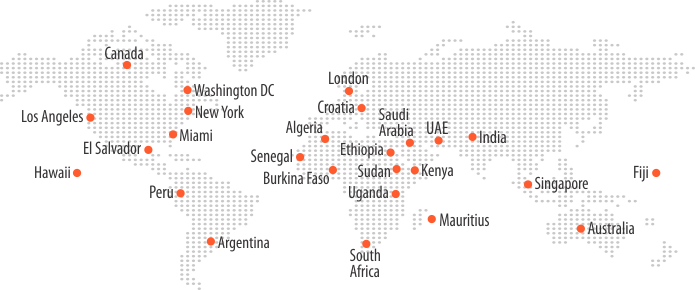Forecast 2021: What’s Trending in the Telecom Industry

2020 remains to be a year of irony. While some industries struggled to survive, few others had the challenge of addressing the massive surge in demand. One such industry was telecommunication that saw a jump in demand when most offices and schools across the world shifted base. There was a manifold increase in the demand for telecommunication services primarily the data services that support collaboration and communication. The good news is that despite such a sudden need, the industry was able to rise to the challenge and deliver. As the remote working trend now becomes a way of life with larger enterprises like Twitter announcing indefinite work from home, the data demand refuses to die down.
The scenario makes for an interesting case study on how the industry can withstand the challenge while building a future on it. 2021 makes for a promising base for the foundation laid down in 2020. The technologies like SD-WAN (Software-defined Networking in a Wide Area Network), edge computing, and virtualization that were considered emerging not so long ago have become a necessary part of the infrastructure.
Here are some top trends for 2021 that will shape the future of the industry
The 5G Revolution
5G has been the talk of the town for a while now and is gradually taking shape in several countries. It is slated to go even bigger in the year 2021 with more and more carriers filling out their 5G networks and hardware capable of 5G implementation.
US wireless giant T-Mobile and Sprint have announced nationwide 5G coverage by the end of 2021, thereby pushing the rivals AT&T and Verizon to accelerate their time to market. In September 2020, AT&T said it is currently in the process of testing and developing its standalone 5G core. New Jersey-based Verizon too recently announced that it expects to generate 5G mobility service revenues in 2021.
Thriving Artificial Intelligence and Machine Learning
The year 2021 will see 5G technology acting as a medium to drive integration of Artificial Intelligence (AI) and Machine Learning (ML) within the telecom ecosystem. This next-generation wireless networks will leverage AI and ML to forecast end-user distribution, predict peak traffic, and enhance network capability. Telecom companies are set to benefit from the opportunities created by the prominence of AI and ML to boost network experience and curtail network cost through automation. AI-based communication will further lead to the development of smart cities by facilitating decision making based on real-time data.
Currently ISPs are investing heavily in AI as it is helping form a smart and much-needed layer within the telecom industry. Both conversational and transactional chatbots are an example of artificial intelligence, while customer service and network optimization are its key focus areas. As per reports, the global artificial intelligence market size that was valued at USD 39.9 billion in 2019 is expected to see a CAGR of 42.2 percent by 2027.
Penetration of IoT
The telco industry, like many industries, bore the impact in 2020 due to the local lockdowns in different counties due to the COVID-19 pandemic. Businesses and consumers both relied on data services this year more than ever as employees moved off the office premises into their homes, schools had to give way to online classes, and several businesses explored new ways to keep their doors open, using technology to facilitate touchless interactions enabled by the network.
The Internet of Things (IoT) has regularly featured in several trend analyses for the last couple of years but 2020 made this technology a mandate and one of the most significant trends to impact the telecom industry. The COVID-19 pandemic forced businesses around the world to find new ways to keep themselves relevant. From pop-up healthcare clinics in parking lots, online shopping, and touchless delivery at retail stores and restaurants, connectivity in new places and devices were important to keep certain industries up and running. IoT ensured that the connection between the devices, endpoints, and assets are seamless helping businesses to be omnipresent.
In 2021, demand for new IoT-enabled applications and solutions will be on the rise, largely being driven by hospitality, healthcare, smart offices, remote asset monitoring, and location-based services, as some employees safely return to the office. An efficient Network switching solution in the form of unified communication has now become an imperative for the user and therefore an important factor for the solution providers.
Rise of Edge Computing
The fate of edge computing was affected massively just like 5G due to the massive upsurge in the networking requirements. The technology brings computing closer to the data source, thereby optimizing internet devices and web applications. With organizations moving towards new ways of operating, IT too needs a revamp with a more innovative and focused approach.
Although edge computing is currently fragmented, according to a report by Gartner, it will witness the rise of new use cases in the next couple of years. In order to tap this market, the organizations must identify targeted areas, and develop ecosystems combining market knowledge with critical systems, software, location, and integration assets. 2021 will give way to use cases such as remote inspection, monitoring, and employee safety which will strengthen the future for edge computing. It is also expected that public cloud spending will take a step back in 2021 in favor of edge computing, as businesses will move towards local data storage.
Network Virtualization
Network Virtualization helps businesses to consolidate their physical network into a single, virtual network. Due to the increasing demands for stable IT infrastructure across the world, network virtualization is becoming increasingly popular among corporates looking to simulate traditional hardware, such as servers, storage devices, or network resources. The technology can be leveraged by small as well as enterprise-level organizations.
As per a report, Network Function Virtualization (NFV) market is expected to see a staggering CAGR of 30% in 2021. New technologies like network virtualization, have helped communication service providers in cutting operational costs, improving business agility, and automating network and security protocols. While several telecom operators are gradually deploying NFV and deriving benefits out of it, there still is tremendous scope for further expansion of this technology.
Recreating the Telecom Landscape beyond 2021
The telecommunications industry has proved its worth during the pandemic and is slated to only grow bigger as the world is gradually settling for the new normal. Now how can the industry keep this tide running in their favor?
Customer is the focus for any industry and therefore putting extra efforts into customer engagement will only make the role of the telecom industry stronger. Currently, the customer needs are high on digital content. The churn rate of the top OTT services in the United States climbed from 35% in Q1 2019 to 41% in Q1 2020. This is a particularly unexploited sector that is turning into a hotspot due to the massive original content being developed across streaming services. With such increase in the number of online users, fraud management plays a crucial role in ensuring the user data is secured through innovative technologies provided by architecturally superior platforms like MobiFin Elite.
5G networks have the capability to revolutionize every industry, from manufacturing to health care and even government. Enabling 5G is not the end to the road, but it is important to bridge the gap between different technologies and integrating edge computing with say, IoT devices such as sensors. Together, 5G connectivity, robust computing power, and artificial intelligence can create an edge for the telecommunications industry to unlock its potential.
Bankai Group is constantly evolving itself to be a game-changer in this scenario helping the industry to seize the moment through innovative telecom solutions and services catering to the various aspects of a successful enterprise. Our wide range of offerings has helped corporates, small, medium, and large, to streamline their operations as well as offerings for over three decades. Connect with our experts and understand how we can help you take charge of your business.
Related Posts
Overhauling Telecom Industry Amidst COVID-19
Telcos: Transforming Communication & Fuelling Smart City Ecosystem





